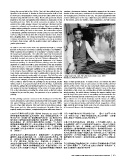Page 552 - Bonhams Chinese and Comtemporary Paintings Nov 2014 Hong Kong
P. 552
During the second half of the 1950s, Chu Teh-Chun shifted from the maintain a harmonious balance. Immediately apparent are the various
figurative to the abstract. A Nicolas de Stael retrospective held in Paris shades of blue and green, reminiscent of a mountain’s green slopes or
in 1956 had a deep influence on him, but by the early 1960s Chu was the changing hues of waves on the sea. The artist supplements with
already freeing himself from the colour blocks and geometric shapes a warm yellow-green at the top, a light blue-green (almost turquoise)
inspired by de Stael and exploring new territories in abstraction. In this at the bottom, and in the middle a deep cobalt blue, and with various
beautiful work from 1963, his artistic maturation is evident. As they
evolved, the earlier opaque shapes and contours dissolved on the
canvas into ethereal and translucent planes. More importantly they
capture motion: reviving the essence of traditional Chinese painting and
to the hand holding the brush to the canvas, his brushstrokes express
a tremendous powerful movement. On this canvas he uses both wide
and long oblique strokes (made with a large brush) and short, thinner
lines disrupting them. The strong movement of the large brushstrokes
continues outside the bounds of the composition—the frame insufficient
to harness their energy—with the painted surface just a glimpse of a
greater phenomenon.
As often in Chu Teh-Chun’s work, this splendid example is a unique Ching Chao-Chu, Chu Teh-Chun in his studio, circa 1960.
junction of European and Chinese painting techniques and traditions. ©atelierctc ©ADAGP Paris 2014
While exploring the possibilities of oil painting—complex textures on
the canvas and vivid opacity—the artist at the same time demonstrates tinges of dark greyish green. To balance these cool colours the artist
his mastery of the brush, with a visible large brushstroke of impressive added several warmer areas of sand colour, and two earthly ochre-red
controlled strength, as seen in the best Chinese calligraphies. The patches at the centre. There are also some black streaks and, perhaps
composition also has the metaphysical dimension of a Chinese more importantly, white paint mingled with green in some of the large
landscape painting. In classical Chinese painting, even the simple brushstrokes, that create eye-catching lines of light and brightens the
depiction of a solitary rock with a spray of bamboo at his side embodies whole painting. The subtle balance between the warmer earthly tones
a whole landscape, and thus embodies the whole universe. However and the large blue-green areas is compelling and demonstrates the
modest the Chinese landscape painting is, it is a microcosm: offering impressive maturity already achieved by Chu Teh-Chun at this stage.
to the observer the possibility to see beyond the landscape but also, to These colours are of a classic landscape but the shapes are shifting
come inside and wander, even when a visible path is absent. Like his and unstable, as if in a midst of a transformation. The concrete forms
traditional counterparts creating with ink on paper, Chu Teh-Chun also seem to have eloped, leaving only behind vibrant suggestions of their
aspired to show something beyond the visible: this painting providing an flight, full of life and energy. In this work, Chu Teh-Chun creates a world
impression of sweeping movement expanding the limits of the canvas. of its own and takes us into its imaginary territory.
From a Chinese point of view, the painting has the qi (energy, breath)
flowing inside it. As qi goes through all life and all things, it permeates
the universe, giving it life and binding it together. As an aesthetic aspect,
qi is present in the true masterpieces in the canon of Chinese painting.
It is a vital dynamism pervading the whole work, a vibrant tension
between the yin and the yang. The presence of qi is patent in this
painting.
As this painting captures a moment in the development of Chu Teh-
Chun’s abstraction, it also evinces an important shift in his palette during
that period. Relying primarily on black and brown in the early 1960s,
Chu Teh-Chun shifts between 1962 and 1963 to more riotous colours.
Blue, green, red, etc. take greater importance in his works. Here, he
employs mainly cool colours, complementing them with warm tones to
1956年在巴黎舉行的尼古拉斯.斯達爾(Nicholas de Stael)回顧 空間。中國學者會形容這種氣勢為「氣」,一個全宇宙必不可少的
展對朱德群的藝術風格有重大的影響,啟發了他抽象畫的發展。但 力量。體現出「氣」是傳統中國畫能達到之最高尚的地位,而朱德
到1960年初,朱德群已放下斯達爾的顏色和形狀,而這幅1963年的 群在這幅油畫中徹透地表達出這精彩的張力。
傑作體現了他對抽象風格的創新演釋。隨著演變,畫布上的形狀和
輪廓逐漸融為一體,變得超凡飄渺並具有極大的動感,令人想起中 這幅畫是朱德群藝術發展的一個轉折點,不單是筆觸上的進步,顏
國傳統書畫栩栩如生的筆墨。畫布上強而有力的筆觸夾雜了較細膩 色也逐漸改變。從六十年代初主要的黑色和棕色,到1962年開始比
的筆劃,每一筆都流露著藝術家所發揮的龐大力量。畫中幾乎可觸 較鮮艷的色調,如紅、藍、綠等等。此作最奪目的就是不同濃淡深
及的動感似乎超出畫布的限制,作品彷彿只是一個更宏偉現象當中 淺的藍綠色,從帶暖調的綠色到深鈷藍色,像山脈廣袤的山坡,或
的一部份而已。 海洋變化無常的色調。雖然這幅畫主要是冷色調,但朱德群為了保
持其和諧的平衡也灌輸一些溫暖色調,如中間的土紅色。而這些強
此作是朱德群令人驚嘆的抽象畫中一個精彩的例子,充分體現他交 烈的色彩中,白色和黑色捕捉並反射光線,令作品變得更生動。朱
融東西方傳統和技術的風格。他一方面探索油彩獨有的質感、艷 德群駕馭多種不同顏色,證明他的技術在這個階段已令人欽佩且成
麗,同時透過富於情感的筆觸展現他熟練的水墨技術。中國傳統畫 熟。
中,單是一顆石頭和一抹竹葉已代表一整個景觀,甚至整個宇宙,
而此層次的抽象意念在朱德群的畫中顯而易見。作品令人著迷的風 這些形狀和顏色像經典的風景畫,但動盪不定的輪廓彷彿正在演變
景吸引著觀眾,同時邀請他們聯想觀景以外,更宏偉的現象。這張 中,就如它們溜走了,只剩下身後充滿活力的痕跡。透過此作,朱
作品所具有的力量超越可見的層面,洋溢動感的筆觸擴展到觀眾的 德群引領觀眾進入他所創建的虛境。
Fine Chinese Paintings and Contemporary Asian Art | 101

